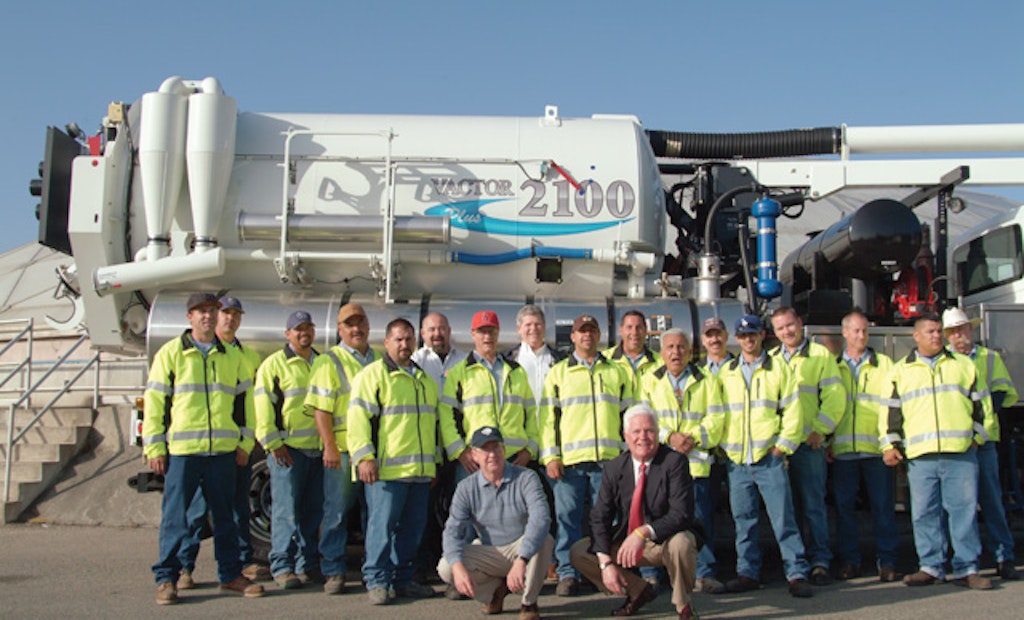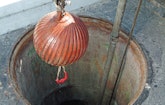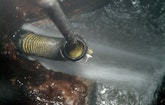
Interested in Cleaning?
Get Cleaning articles, news and videos right in your inbox! Sign up now.
Cleaning + Get AlertsThe Collection Facilities Operation and Maintenance Division of the Orange County Sanitation District in Fountain Valley, Calif., holds the enviable position of having only a minor backlog of sewer repairs. That is quite an accomplishment for the third largest regional wastewater agency west of the Mississippi River.
The district stays on top of problems by relying on strong collaboration with 21 cities and three special districts representing 27 satellite utilities within a 480-square-mile service area. Its successful practices include outsourcing repairs to local contractors who use the latest technologies, allowing its own workforce to remain at 25 people.
In 2001, the district prepared for a sewer management plan that would extend the life of its assets rather than just replace them through large capital projects. The program involved aggressive inspection and maintenance, chemical dosing to control corrosion and odors, and public education on best management practices.
Regulatory driver
The district’s two wastewater treatment plants handle dry-weather flows of 207 mgd generated by 2.6 million people in central and northwest Orange County. Almost half the treated water is recycled for aquifer recharge and half is returned to the ocean. In low elevations, 15 regional pumping facilities help convey the wastewater.
The district also owns 176 miles of small-diameter sewers in the city of Tustin and surrounding unincorporated areas, and 403 miles of regional interceptor and trunk lines. Small- and some medium-diameter vitrified clay lines are almost 50 years old. Lines 42 inches and larger are corrosion-resistant PVC-lined T-Lock concrete pipe (Ameron International Protective Lining Products). The replacement value of the collection system is estimated at more than $3 billion.
In 2002, a regional Waste Discharge Requirement Order required the district and satellite utilities to adopt sewer system management plans and FOG reduction programs to combat sanitary sewer overflows (SSOs).
“The order expanded our collaborative efforts,” says Nick Arhontes, P.E., director of the Facilities Support Services department. “We still meet monthly to share information and improve regulatory compliance, and for staff education and training.”
District staff and a consultant worked with the cities to develop best management practices. During the process, officials learned that most restaurants did not have grease traps or interceptors. “Once we discovered the omission, we met with other agencies’ plan checkers and regulatory people to stress the importance of following the plumbing code and requiring them where specified,” says Arhontes. “That was one big quick win.”
Educational endeavors
The other quick win was providing educational materials and best management practices to foodservice establishments through the Orange County restaurant inspection program. The BMPs listed easy-to-do requirements such as posting pumper manifests, installing screens in sink and floor drains, removing grinders, reclaiming oils and grease, and educating staff with posters on how to follow the guidelines.
“We told restaurant owners that if they adopted BMPs, we would not require them to install more hardware or interceptors,” says Arhontes. “Many saw the wisdom of how compliance could save them money, and we’re beginning to see success.”
High-density residential communities such as apartment and condominium complexes have their own grease problems. The district, health departments, and occasionally regulators work with property owners to implement better management and education programs for residents.
“The big wins have come through education,” says Arhontes. “One such effort was the Drain Is Not A Dump campaign, which told how to properly dispose of FOG, pharmaceuticals, and other products that should not be poured down drains.”
The district still has some grease hot spots, but the recurrence rate is declining with the use of modern tools and a regular cleaning schedule. Small-diameter pipe in root-prone hilly areas is on a 12-month cycle, while an 18-month cycle is appropriate for flatter sections. District staff manages the hot spots using one of two Vactor 2100 combination cleaning trucks, while contractors do inspections and production cleaning. “It’s a good mix,” says Arhontes. “That’s why we’re seeing fewer spills.”
Quality specifications
Arhontes believes the district is a leader in adapting programs to site-specific circumstances. “Operators have to understand their infrastructure, what is causing the problem, and what is the appropriate method and frequency to remove debris,” he says. Since 2004, contractors have inspected all of the small- and medium-size pipe system and about 80 percent of the trunk and interceptor lines.
“The vitrified clay pipe is durable with minimal cracking, so we specify cured-in-place pipe or Am-Liner fold-and-form PVC liners (Sancon Engineering) from manhole to manhole or for spot repairs,” says Arhontes. Contractors have rehabilitated or spot-repaired five miles of the 175-mile system. They rehabilitate manholes with sprayed-on high-built Sancon 100 or 200 coating systems.
“Adequate surface preparation is the key to any successful liner or coating process,” says Arhontes. “If pipes have significant structural damage, they are repaired with Ameron Arrow Lock, a heat-welded bonded sheet liner, or Linabond, a polymer-adhered PVC sheet liner.”
Even the simplest repairs have material-based specifications in accordance with engineering department standards. “Good specifications enable us to hold contractors accountable,” says Arhontes. “We review the manufacturer’s specifications, then specify any options. Our specifications state exactly how we want the work done.” Pipe and coating inspectors from the engineering department visit projects frequently to ensure that contractors take no shortcuts.
In 1991, the district had 12 SSOs due to roots in homeowner laterals or in local sewer pipe joints and structural cracks. After the start of an aggressive root cutting and chemical abatement program, the district had three SSOs in 8-inch pipes in 2010 — one from grease and two from roots. Every year, contractors treat two miles of pipe with Sanafoam herbicide from Vaporooter. A piggyback agreement allows the City of Los Angeles to treat some district lines with RootX chemical formulation.
Custom-built solution
While blockages are the main risk in small-diameter pipes, odor, corrosion, grease, and grit are the major ones in large- and medium-diameter pipes, in some wet wells, and in the district’s 110 inverted siphons. Workers clean the siphons using custom cable-rigged equipment built by Morgan Co. in Fontana, Calif.
The chassis-mounted units have a hydrostatic drive for the cable reel system instead of a rear auxiliary engine. Rather than buckets or clamshells, the cleaning device is a tire pulled horizontally from the upstream to the downstream manhole. The tire helps scour grit and some grease chunks from siphon inverts and gravity sewers.
Initially, a district worker did a confined-space entry of a manhole, then used a shovel and 5-gallon bucket to collect grit that was hoisted out and dumped into specially designed trailers. The O&M staff then developed a more effective process using a Vactor combination sewer cleaner with positive displacement blowers to vacuum grit from the water. The method minimized confined-space entries.
Success with the older truck led to the delivery of a new Vactor 2100 Plus combination unit in March 2011. Its Intelliview electronic system allows operators to monitor blower temperature, flow, pressure, and system diagnostics so that the machine runs safely and at peak productivity.
Routine site-specific cleaning keeps the debris minimal and easier to remove. The most problematic inverted siphons are cleaned monthly. The frequency decreases to quarterly and semiannually depending on the asset’s history.
Life extension plans
The district fought a running battle with major corrosion and odor problems in medium- and large-diameter trunk lines more than 20 miles long. In 1987, it began slug-dosing them with sodium hydroxide (caustic soda) from tanker trucks. In the early 1990s, the team developed an odor and corrosion management program that evolved into today’s chemical dosing program.
Nine liquid chemical feed stations, furnished, installed and maintained by Hill Brothers Chemical Co. and US Peroxide, cumulatively dose 3,000 gpd of ferric chloride, 400 gpd of calcium nitrate, and 2,500 gpd of magnesium hydroxide. The package systems store the chemicals in 2,000- to 12,000-gallon tanks and dose them at controlled rates into lines leading to the large sewers. “If you look at the physics, we’re minimizing odors by controlling corrosion,” says Arhontes. The program costs $6.5 million, or 32.5 percent of the collection system’s annual $25.6 million budget.
In 2011, the district began its first design-build project: sliplining five miles of the 48-inch PVC-lined concrete Magnolia trunk line to rehabilitate failed welds in the 60-year-old vinyl pipe and stop corrosion. The O&M staff is using centrifugally cast fiberglass-reinforced polymer mortar pipe from HOBAS Pipe USA. “The district’s engineering department decided that the design-build process should save time and be less expensive as compared to its traditional design-bid-build process,” says Arhontes.
The district has a 100-year approach to asset management with a 20-year forecast. Its staff collaborates with 25 board members to develop progressive five-year strategic plans, while the engineering department manages a five-year capital improvement program. It uses the Esri GIS system to map assets, but the coordinates are from the state’s land-based survey. Technicians can acquire coordinates in the field using handheld Trimble GeoExplorer GPS units. Other advances include upgrading the maintenance management software to IBM Maximo and providing field crews with Wi-Fi laptops.
Arhontes believes the district’s greatest challenge will be maintaining a sustainable revenue stream. “Our goal is not to replace all sewers,” he says. “Our goal is to inspect and repair them to extend service life. That is the best way to demonstrate fiscal responsibility to our customers.”
















